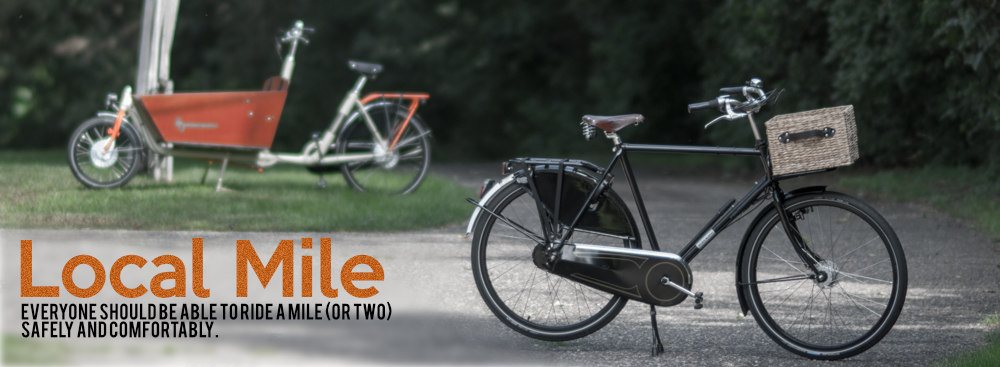The heater and stones are the heart of a sauna and the convective loop and löyly cavity they create are its soul.
Stones
In a good sauna bathers are heated by even convective heat produced by the stones and the stones are heated by the heater. The stones are critical for three things;
- The primary purpose of the stones is to convert as much of the heat produced by the heater as possible to convective heat. Heat is transferred to the stones by conduction, radiation and convection. Then a significant volume of air flowing up through the stones takes on heat from the surface of the stones to become the convective heat that heats the sauna and us. They act kind of like a primitive or natural heatsink (think cooling fins on electronics) – draining heat off the firebox or electric calrods and dissipating that heat in to the air where it becomes the convective heat that we want.
- The stones are important in producing the steam that is critical to lóyly. When water is thrown on the hot stones, steam is produced and flows with the convective loop.
- The stones help to soften and even out temperatures over time so that there are not uncomfortable high/low swings. They store excess heat when a lot is being produced and give off that excess when little is being produced (a heat capacitor) which provides a more even and enjoyable heat for bathers.
Aluminum or steel sheet metal that heaters are made of doesn’t do what stones do. Stones are critical.
Nothing makes up for proper stones!
More Is Better. If possible a MINIMUM of 6kg / m³ of space is a good starting target though some sauna builders in Finland and Sweden I’ve talked with say 8kg / m³ is their minimum. More is better so 10-12kg / m³ is better up to about 16kg / m³ (or about 1/3 lb / cubic foot minimum to 1 lb / cf). Beyond that may be getting in to some diminishing returns so while perhaps still better, only marginally. More stones result in more even temps, more even softer steam and thus a more comfortable experience. More stones results in more negative ions which may make us feel better.
For perspective, a smoke sauna in Finland will have about 90kg of stones per m³ and for a Banya they aim for 20-40kg per m³.
These targets can be difficult to reach with some heaters from Harvia and others in which case we do the best we can. Maybe 4-5kg / m³ is the best we can do.
Functional vs Non-Functional – In a tower heater only the upper stones are active or functional. The lower stones are mostly just decorative. This varies a bit by heater but very roughly only about half of the stones, the upper half, are functional in producing convective heat and in producing steam. When we say that we need a minimum of 6kg / m³ of sauna volume, that’s 6kg of Functional stones.
Bigger Is Not Better – Stones should be about 5-15cm (2-6”) in size with most perhaps 4-8cm. Surface area is important, too big of stones will result in too little surface area to mass. Too small of stones will not have sufficient mass, will disintegrate and not last long, and will not allow sufficient convective airflow.
Rough and Irregular Is Good, Round Not So Much – Stones should ideally have a rough and irregular surface. This increases their ability to produce convective heat, helps hold tiny pools of water to make better steam and they stay in place better than round. Smoother or rounder stones do not do this so well. If you want the look of rounder stones then maybe use them only for the top layer.
Commercial Virgin Quarried Stones – Landscape stones or river rock may have organic matter (think cow dung) that is unhealthy and can produce unpleasant and unhealthy odors when heated and this can take years to burn out. There is also potential for stones to contain arsenic, asbestos, sulphur or other undesirable elements. Rail ballast often have oils and asbestos. Commercial sauna stones are relatively assured to be able to tolerate heat and to be free of undesirable compounds.
Stones from along lakeshores can be quite good if they are not under water constantly (if they have green stuff growing on them you don’t want them). Whatever you choose, wash them well with only water and burn them for a long time before using with humans present.
Olivine diabase are a volcanic stone that some Finns believe are the ideal option. Gabro and Peridotite are also good.
Ceramic Stones – These can work quite well though there is some evidence that they can cause the calrod elements in some electric heaters to overheat and break so check with your heater manufacturer before using.
Warm New Stones Slowly – Stones collected in nature may sometimes have pockets of water inside them. Three hours @ 50°c, 3 hrs @ 75°c and 3 hrs @ 100°c with a day or half of cooling down between without anyone in the sauna will allow the water to either dissipate or if the stone is going to explode to hopefully do so without hurting anyone.
Deeply Stoned – You want at least 3-4 courses of stones on top of each other and on top of the heat source so at least 40cm or 16” of depth is recommended.
Flat Up – Placing stones so that the larger flatter surface is up and very slightly tilted towards the center of the heater will result in the most steam.
Loosely Packed – Air needs to flow freely up through the stones to create the convective heat that we want. They should not be packed too tightly and should not block airflow from vents around the bottom that allow air in to the stone basket.
An excellent article from Lassi valuable for the first loading and replacing: How To Replace Sauna Stones In Your Electric Or Wood-Burning Heater.
And a previous one: How To Know When To Replace Stones.
Harvia also have a good discussion: here.
Sauna Heaters
Sauna Heaters, called a Kiuas in Finland, are designed in a very specific way to provide a very specific heat. Kiuas is often translated to stove in english but that is not accurate. According to a number of people in Finland I have a high regard for, a more accurate translation of kiuas is ‘sauna heater’ so that’s what I use and reserve stove for devices that are indeed stoves.
A good sauna is heated by convective heat from the stones and the heater that heats these stones, the kiuas, is critical. A sauna heater should:
- Have a properly large and deep stone capacity with significant airflow up through it.
- Heat the stones.
- Contribute to the Convective Loop.
- Produce very little radiant heat to the front, back, or sides.
- Keep the heat source close to the floor and the stones low since benches must be above the stones.
- Steam produced only from Stones. Never from steel or other elements.
In a sauna you want to experience heat from convection and not feel any radiant heat from the heater. A good convective loop is critical to a sauna as without this the sauna will feel ‘dead’, CO2 and other contaminants will not be removed and our skin can overheat which prevents us from benefiting from the heat.
Radiant heat is uneven and directional, it only heats our bodies on the side it’s radiating from and is very uneven inch to inch and second to second. Heat from convection is more all encompassing. In a well designed sauna it will heat all sides of our bodies evenly which is more comfortable, can help to carry the steam to us via the convective loop, and is what a sauna is all about.
Note: Everything produces radiant heat. There is a lot of radiant heat in a sauna just as there is everywhere around us everywhere we go. We can’t escape the radiant heat that’s produced by the wood walls and even the person sitting next to us. But radiant is directional and uneven so we want to minimize it and keep it as even as possible.
You want as much of the heat produced as possible to rise up as convection airflow and contribute to the convective loop that forms the löyly cavity and as much of this as possible to do so via heating the stones. You want as little as possible to go to the heater carcass which will result in undesirable radiant heat. In other words, you want all of the sides of the heater to be as cool as possible.
This also helps with placement in the room as clearances to combustibles then is less and allows you to get the heater and the stones closer to the heater wall which results in a better convective loop and so a better löyly cavity, and is greater distance from bathers which further reduces radiant heat on them. This applies equally to wood or electric heated and hard sided vs open mesh sided.
The design of electric heaters is fairly straightforward as the calrod heating elements are in the middle of the stones. The outer stones stay cooler and help to reduce radiant heat and so most of the heat rises up heating the stones above and contributing to the convective loop.
Wood heaters are trickier because they have a big steel fire chamber in the middle. The traditional design for these is to have three layers on all sides; fire chamber walls + air channel + thin outer carcass. The air channels carry heat from the sides of the fire chamber upwards through the stones. This airflow is critical for the stones, helps the convective loops in the sauna, gets more of the heat produced by the fire to the stones, and reduces the amount of heat radiated to the sides.
While a wood stove to heat a room with radiant heat will be made from thick (1/8” – 1/4”) heavy steel, a low radiant sauna heater is intentionally made from much lighter and thinner materials like 1/8” for the firebox, 1/16” for the inner carcass and 1/32” for the outer carcass. The outer carcass being thin does not conduct heat as well as thicker heavier steel and so also helps to reduce radiant heat on bathers.
Note how the upper part of the firebox and the flue are used in all of these to transfer as much heat to the stones as possible to produce the greatest amount of convective heat.
Here is how this works in a heater from Helo.
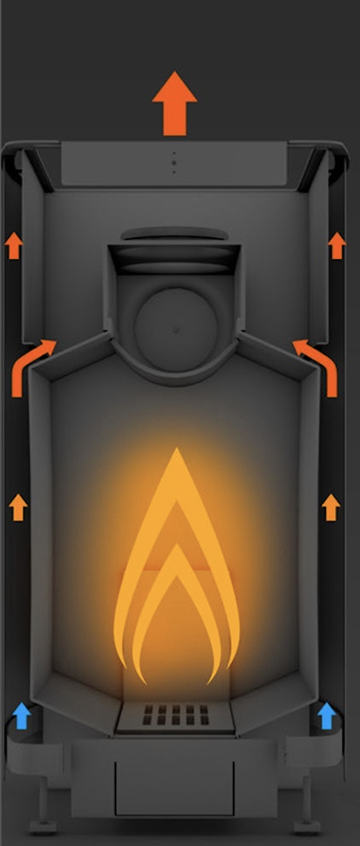
And from Harvia: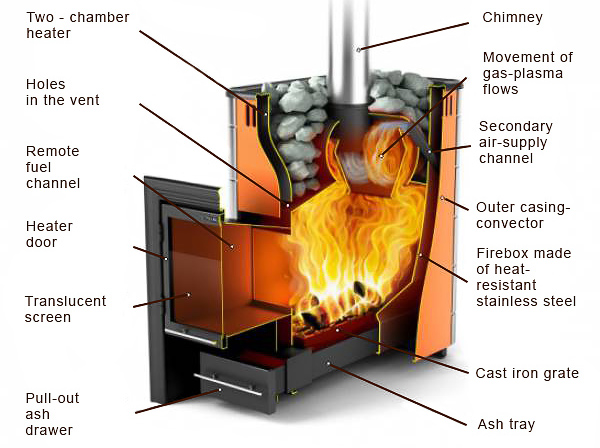
A Narvi NC-20 (by C Macqueron):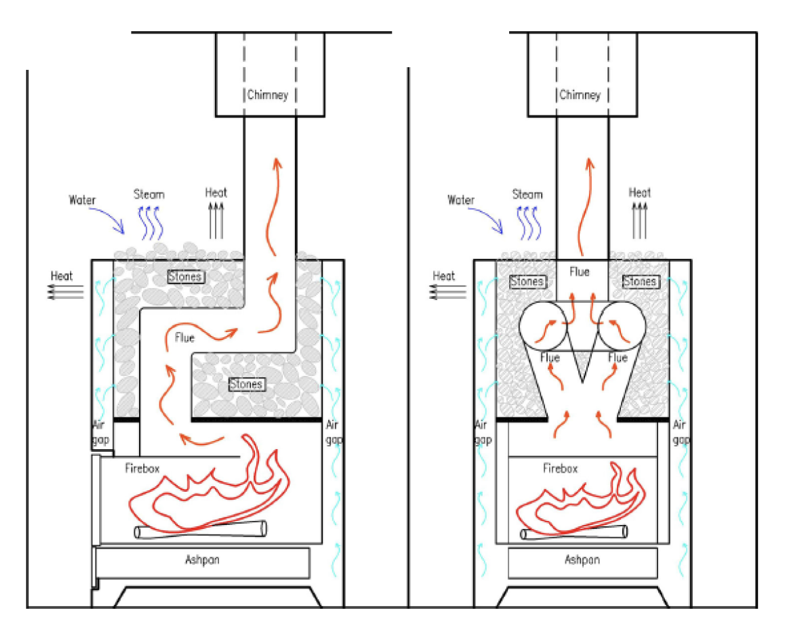
The inside of an Iki. Like others, the firebox is kept very low and both the firebox and flue are designed to transfer as much heat to the stones (and thus become convective heat) as possible. 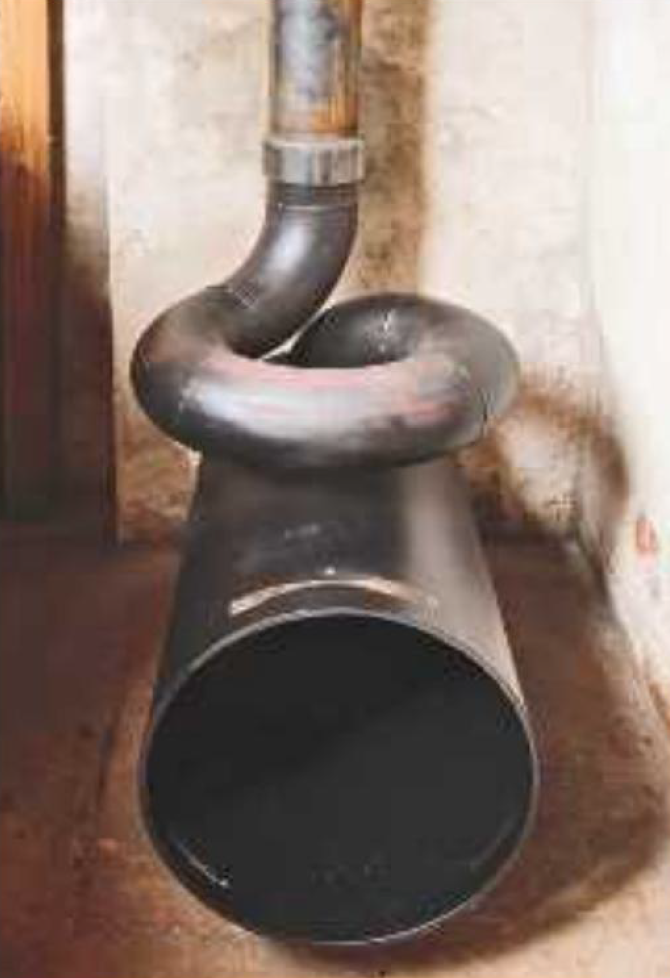
An alternative introduced by Iki in the late 1990’s is to replace the side air chambers with stones and have an open mesh outer carcass. This further reduces the amount of radiant heat, increases the stone mass and increases the amount of heat contributing to the convective loop. Other manufacturers soon followed with similar designs.
The Löyly Cavity – A closed sided heater may generally have a more defined löyly cavity than an open sided (or mesh) heater. For any given ceiling height and stone height then the close sided may provide a better löyly cavity with less stratification than an open sided will. The open sided is however more forgiving if the foot bench must be below the top of the stones. Keep in mind that steam may not descend as low.
Be Careful – Check The Specs – Some electric heaters aren’t designed to deliver even the 90°c/194°f the UL limits saunas in North America too. Some heaters have very minimal stone capacity. Some produce too much radiant heat. These are all things that make significant differences. A Harvia and Narvi may look the same but perform very differently. There’s a reason better sauna builders in Finland prefer Narvi.
Safety Distance & Radiation – One way to get an idea of how much radiant heat a heater will produce is looking at the safety distances to combustible material (not the safety distance to non-combustible) as this is a measure of radiant heat.
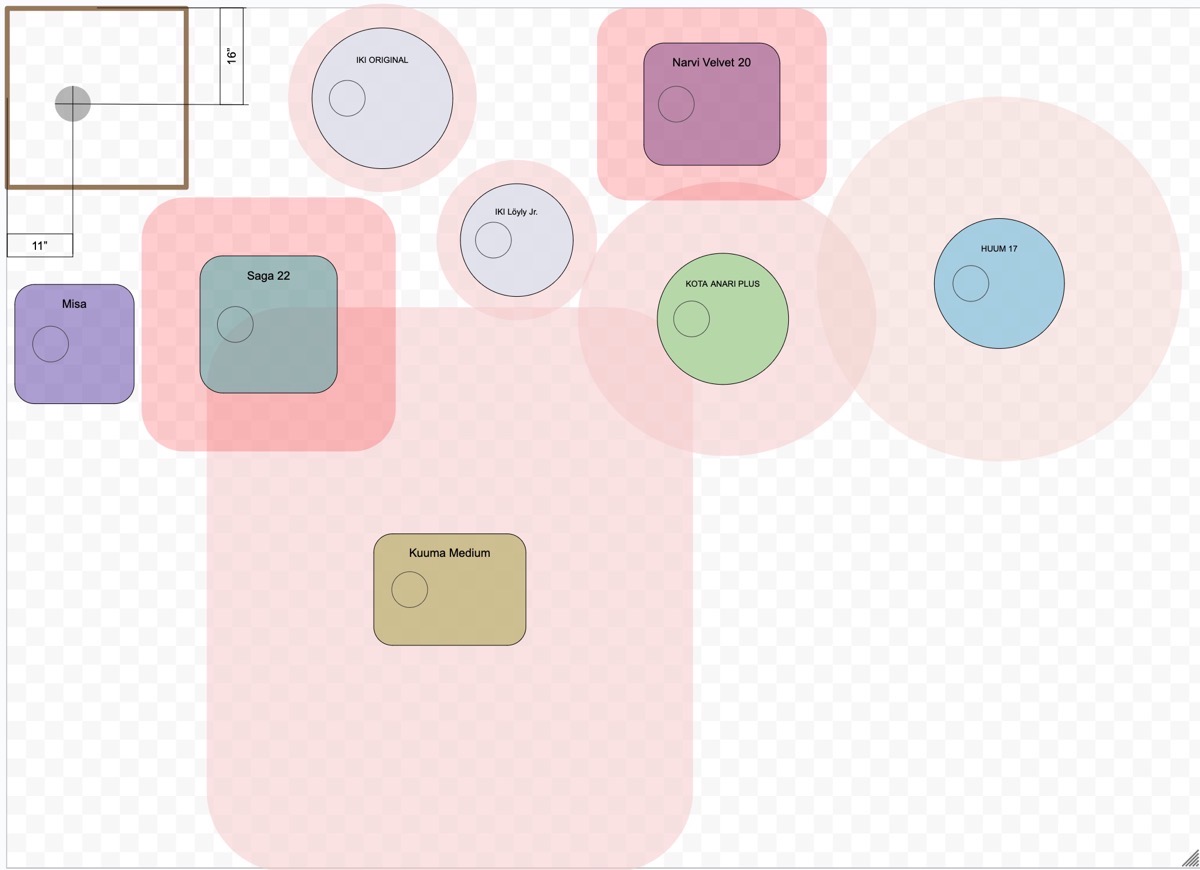 This chart by Christopher ‘Risto’ Rice provides a good glance at how much radiant a few heaters produce (and why Narvi and Iki are so valued by sauna builders in Finland and elsewhere).
This chart by Christopher ‘Risto’ Rice provides a good glance at how much radiant a few heaters produce (and why Narvi and Iki are so valued by sauna builders in Finland and elsewhere).
For example, an original IKI is 100mm (4”) to combustible (largely on all sides) so we know it will produce very little radiant heat. A Harvia Legend is 200mm-500mm (8-20”) so considerably more than the Iki. A Helo Karhu is 300mm (12”) on sides and 500mm (20” to the front) and the Harvia Pro 36 is a wapping 500mm (20”) on all sides (though it is intended for quite large saunas where it will naturally be a considerable distance from bathers).
A good rule of thumb is that you want bathers (typically knees) AT LEAST 3-5x this distance from the heater and ideally 8x. With most heaters at 5x you can still feel some minimal radiant while 8x achieves the ideal of no noticeable radiant. So at a minimum you want to be at least 500mm (20”) from an Iki but 2286mm (90” or 7.5’) from a medium Kuuma.
Some heavy steel stoves don’t shield the front thinking that’s unnecessary but it is very necessary, especially the corners. Heat radiates in all directions so someone sitting at a 45° angle to a stove will feel just about as much radiant as someone sitting directly in front.
To reduce radiant heat on bathers then you want the front of the foot bench to be perhaps 3-8x the heater’s rated distance to combustibles away from the heater. So if the side of the heater facing bathers is rated for 8” to combustibles then you want the foot bench to be 24-64” from that side of the heater.
Tower / Column Heaters – These are popular because of their aesthetics. They don’t necessarily work so well though. Ideally you still want your foot bench about 20cm (8”) above the top of the stones, even with these which can result in a really high foot bench. If your foot bench is lower an open sided will usually be slightly more forgiving than a closed sided for temps but not so much for the all important steam. The result will still be less than if the foot bench were well above, 20cm or so, the top of the stones. A shorter closed or open sided will result in a better sauna experience. So a Narvi NC @ 80cm or Iki Original @ 65cm high will be a better option.
Wood, Gas or Electric? First, other than a Smoke Sauna, there is no difference in the sauna experience between wood and electric (assuming the sauna has been built properly). A good sauna is heated by the stones and the stones …don’t really care how they are heated. Someone who is blindfolded will not be able to tell the difference in the two. The heat, steam and löyly are the same.
Some people in Finland think it’s funny when Americans with too low of benches and poor ventilation in their sauna say that wood is somehow better. They say that these Americans need to get the sauna log out of their eye before criticizing the speck in others.
Wood is more traditional and more romantic. Wood fires are enjoyable to see, hear and smell (for many people). Even the routine of preparing the fire has benefits and for many of us is quite enjoyable, relaxing and a great way to prepare for a good day of sauna – it’s foreplay for sauna. A wood sauna causes you to slow down a bit and be intentional about your sauna. I would argue that there are likely health benefits to a wood fire in that it can be calming. Wood is the choice for off-grid saunas though improved solar technology is making off-grid electric heated saunas a viable alternative.
Drawbacks to wood are that it is not as convenient, uses natural resources (trees) and is a direct source of air pollution. There is also the issue of impact on neighbors – the smoke from a wood heater is fine in a rural area but could be quite inconsiderate in a more urban or suburban area.
Electric is more convenient, especially with a phone app that allows you to begin preheating before you arrive home. Electric can maintain more even temps than wood. How the environmental impacts of wood vs electric compare is a much longer discussion and may depend on how the electricity is generated. From a cost standpoint, a well designed 8x8x8.5’ sauna will use about 8kWh to heat and then about 4kWh to maintain temp during use. So at $0.15/kWh will cost $1.20 to heat up and then about 0.60 per hour so for 2 hrs of use about $2.40.
Electric got a bad reputation early on because of too little stone mass and problems with ventilation. These were corrected by the late 1990’s with more stone mass and downdraft mechanical ventilation. Even so some people still hang on to the idea that electric is not as good.
One significant drawback to electric in the U.S. are the onerous UL requirements and the problems they pose outlined earlier.
Gas is not as prevalent but can be a good option. It’s critical that a gas heater be well designed and well vented as you don’t want the byproducts of gas combustion in the sauna with you. Some local codes also will not allow remote app control so you don’t have the convenience of electric nor the romanticness of a wood fire.
Inside or Outside Feed? With wood you have a choice of loading wood from inside the hot room or outside. With the key benefit of wood fires being aesthetic – seeing and hearing the fire, there is often not a good reason to have an exterior loading heater as it looses that benefit. There are two instances where exterior loading would seem to make sense though. One is an off-grid sauna but where the owner doesn’t want to carry wood in to the hot room. The second is if the loading is done from the vestibule/sitting/changing/shower area where the fire can be enjoyed by people sitting in there.
Hybrid? I built a hybrid gas/wood fireplace for our house. Natural gas is used primarily to get the wood going but is sometimes kept on if wood is greener than it should be. Similarly, it should be possible to create a gas/wood hybrid sauna heater that can act as a traditional wood heater (with a convenient gas starter) or have the convenience of a gas heater when desired.
One final point. There has been speculation that a wood heater produces beneficial negative ions while an electric either does not or produces positive ions. There has been no study that I’m aware of to support this nor is there a good scientific foundation for it to be true. The steam that’s created when we throw water on the stones will produce a significant amount of negative ions and this regardless of how the stones are heated.
Best Option? – What type of heater (closed sided, open sided or circulating) is best will vary based on the dimensions of the sauna, particularly ceiling height and how each individual model functions within different spaces. Unfortunately we don’t have good data on how various heaters do with regard to thermal stratification and steam. In other words, how good of a Löyly Cavity each produces in what space. Lassi Liikkenan is working on a lab to get some good data on this and other elements and the data collection that we are doing of existing saunas should help as well. Over time selection should become easier and more precise.
Here is a very rough chart to consider:
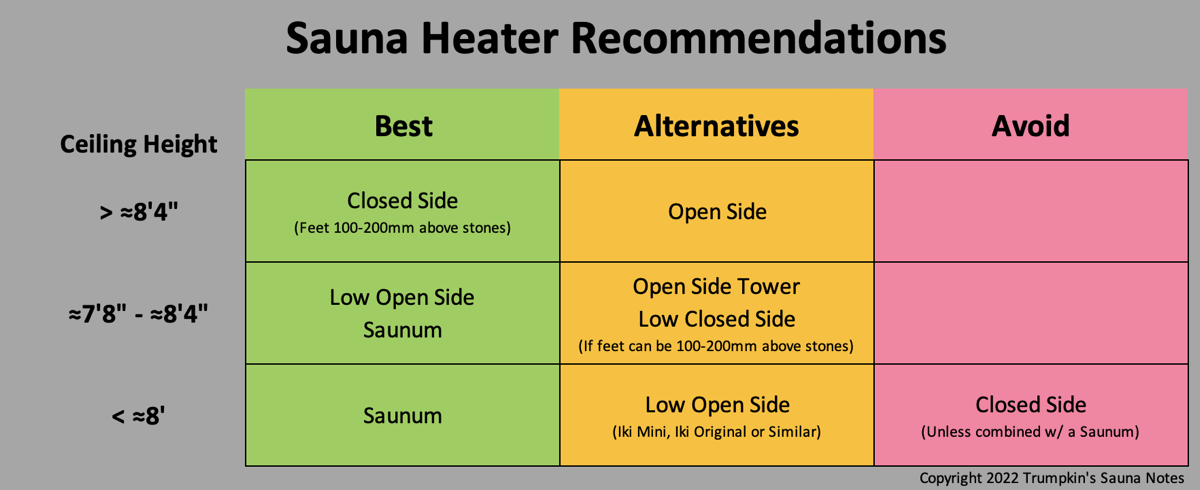
Based on conversations with a number of people in Finland, a properly high ceiling and benches with a closed sided heater provides the best sauna experience (second to a smoke sauna though).
If you can’t get your feet well above the stones of a closed sided heater then a short open sided heater may be the next best option. And if you can’t avoid a quite low ceiling then either a Saunum or adding a convection tube to an open sided heater are likely the ticket. Keep in mind also that a Saunum can be used with a wood heater.
A Convection Tube is a duct that runs up the middle of the stone mass of an open sided heater. It pulls air in from the bottom of the stone mass and produces an enhanced convective loop that can help to lower the floor of the löyly cavity (decreases stratification and pulls steam down a bit lower). The duct should be about 8 – 18cm (3-7”) diameter, probably closer to 8cm on most heaters, and run from bottom to top. At the bottom there needs to be a cavity or duct from the edge of the heater to the convection duct to provide airflow and this should face the benches.
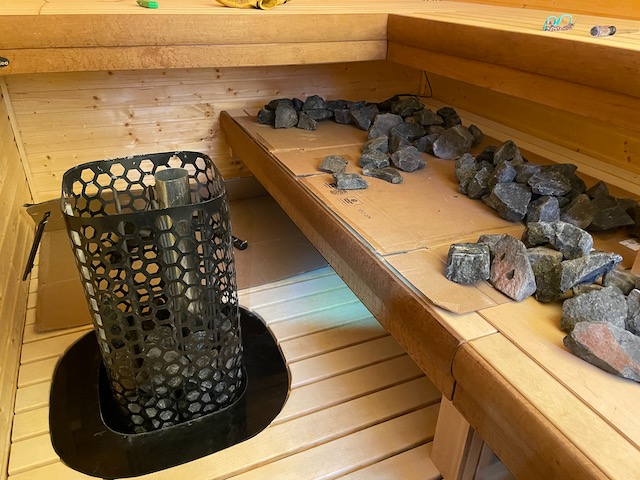
This was originally posited and demonstrated by Sauna_Sitter (Reddit). It is still experimental but early experiments are showing positive results. The photo above is one of my experiments with it in late Nov/Dec 2023 that resulted in about a 4°c increase in temps at the foot bench and importantly, steam going noticeably lower. Overall a very welcomed improvement in this height challenged (7’-11”) sauna.
Bigger Is Not Necessarily Better – Too large of a heater can have a number of drawbacks.
- It Will Short Cycle. Electric heaters work by constantly turning on and off. If you’ve set it for 100°c then it will turn on until the sauna reaches perhaps 103°c and then turn off until it has cooled to maybe 97°c when it will turn on again. With a properly sized heater (and lots of stone mass) these cycles are largely unnoticeable but if the heater has too much power for the space then the heating up can happen quite quickly and be noticeable followed by a long period of the elements being off.
- A secondary and bigger problem of short cycling is that the elements are not on long enough to keep the stones sufficiently hot to produce good steam.
- Larger Temp Swings. Rather than 97°c to 103°c, a too large electric heater can result in perhaps 95 to 110 or 115°c.
- More Direct Radiant Heat. In a sauna we want convective heat, not direct radiant heat. The larger the heater (electric or wood) the more direct radiant heat it produces. This isn’t so much of a problem if the heater is sized properly so that larger heaters have larger spaces and can be further from bathers.
- Evenly maintained lower temps allow for a greater range of löyly from dryer to wetter steam. Too large of heaters cannot maintain lower temps well.
- If interior height is tight then a heater on the smaller side may get the stones down lower in relation to the foot bench providing a more comfortable experience while too large of a heater will have the stones up higher so bathers will have colder feet and actually be less comfortable with a larger heater than smaller.
- Fire Hazard. Too large of a heater can be a potential fire hazard.
Finnish RT Guidelines state 1.0kW per m³ (per 35 cubic ft) for saunas below 10 m³ (350 cubic ft) and slightly less for larger spaces. This assumes that walls and ceilings are insulated, that at least 90% of the wall surface and 100% of the ceiling is soft wood and a proper mass of stones in the heater. For windows or other uninsulated wall areas add 1-1.5kW per m² (per 11 sq ft) of window surface. For stone or similar wall surfaces add 0.7kW per m² (8 sq ft).
Now, to maybe contradict myself. Stone mass is critical so sometimes it’s necessary to upsize a heater purely for stone mass.
And in general stay within the recommendations from manufacturers.
Convenience of Electric and Romance of Wood? – It is possible to have both an electric and wood heater in the same sauna. It requires a bit more space but is doable. The wood heater here is a bit oversized for this sauna as a demo but fun to look at.
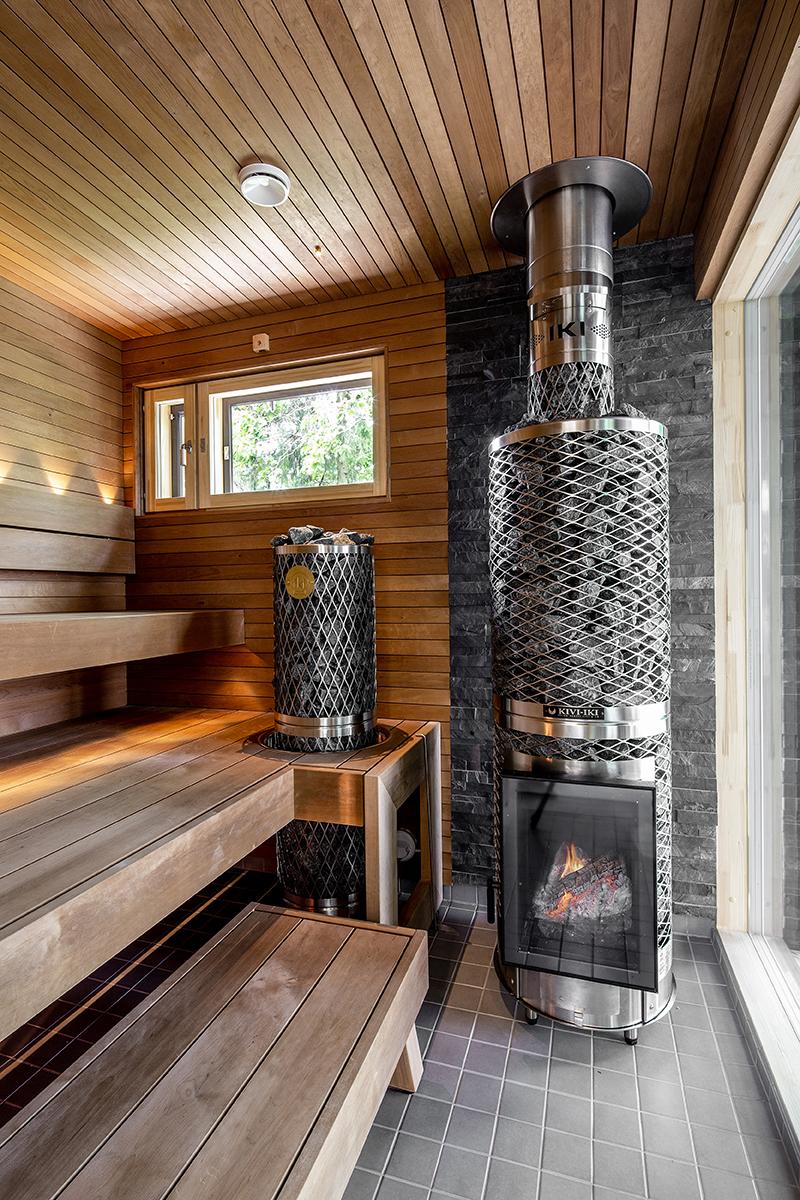
Helo-WT and Similar ‘Technology’ – Some heaters like the Helo Himalaya include a water tank in the middle of the stones. The idea is that you fill it with water and it then produces constant mild steam and humidity throughout your sauna session. The result is kind of a Bio-Sauna though in my experience it doesn’t provide as much humidity as most Bio-Saunas. On most heaters you can remove the tank, put more stones in the heater and the heater and sauna will function like a traditional Finnish sauna. With the tank you get constant very mild humidity and because of the lessor stone mass you get a lessor steam when you throw water on the stones. Without the tank you get a more traditional (or proper according to many Finns) sauna that is naturally rather dry with stronger bursts of steam.
Similar to this are systems like the Harvia Combi that constantly drip water on the stones for a bit higher constant humidity and a more Bio-Sauna like experience.
Manufacturers – Some very brief thoughts.
- Narvi – Generally considered the one of the best among Finns for design, function and build quality. These have a lot of stone mass and very little radiant heat which both contribute to good löyly.
- Helo – Good build and functional quality. A step below Narvi perhaps but above Harvia. This is unfortunately also a confusing array of branding including Sauna360, Tylö, Kastor, Finnleo and Amerec.
- Iki – Introduced the open sided mesh concept in the 1990’s. I would stay away from the towers though as they don’t appear to work as promised and still need feet above the stones.
- Harvia – Harvia is generally a good value brand. Lower quality for both build and function but also lower cost.
- Some of their products have a bad reputation for too little stone mass and producing too much radiant heat so that’s something to watch carefully for with these.
- There have been reports of some Harvia heaters not being able to achieve or maintain promised temps.
- There have been increasing reports of elements corroding very prematurely after a few months of use (they should last a couple of decades at least), particularly on KIPs but also others.
- The new UL compliant Cilandro with enclosed sides should be avoided in almost all cases as it will likely not perform well in any sauna unless you can get the foot bench above the top of the stones.
- The new Spirit should be avoided. The cage that protects the elements takes up a lot of space resulting in very little stone capacity and worse, almost all on the sides where it won’t do much or any good. There is extremely little stone on top. The result will be short heat/cool cycles that are uncomfortable and very poor steam production.
- Aino – Some of the more interesting heaters from an aesthetic standpoint. These can work well but hot rooms must be planned carefully to achieve good results.
- Saunum – For any sauna where you are forced to have a ceiling of less than about 8’ these are probably the best option. My understanding is that this works equally well for electric and wood. These are available in the U.S. as of March 2023.
- Lamppa Kuuma – These appear to be excellent build quality from a company with a reputation for quality products but are not really sauna heaters. These appear to produce more radiant heat than is desired in a sauna and not as much convective heat. With the very limited airflow up through the stones, the stones in a Kuuma are largely decorative rather than functional. These would likely make a great heater for a sweat lodge/cabin though. The new Kuuma Blue Flame is an improvement but still falls far short of a real sauna heater. If they introduce the Kuuma Air I’ll likely be a hearty supporter.
- Nippa, Royale, Grill’D, Other – I don’t know about the build quality of these. Similar to Kuuma these do not appear designed to function well as sauna heaters. Grill’D for instance is 500mm (20”) to combustibles on all sides which is a lot of radiant heat. 3-6” is good with as much as 10” perhaps acceptable for home saunas.
- Ilo –
- Huum – Nobody should support this company for any of their products. They have shown themselves to be lacking in ethics as well as any sense of quality design, testing and manufacturing. I was a fan of Huum and recommended them here and for some specific projects. Two things changed my mind. The first was that they are not properly UL listed which puts anyone in the U.S. using their electric heaters at significant financial risk, they have been dishonest about this and have so far refused to get properly listed. The second was how they treated their U.S. customers with regard to elements burning out very prematurely.
- Heating elements that last less than a year when other mfr’s last 20 to 50.
- Not covering the elements under warranty including refusing such requests from their dealers.
- March 2023 Update: After over 3 years of considerable bad press, including here, they did finally acknowledge the problem and have provided replacement elements for some customers. They have not pulled the bad products from market though.
- May 2023 Update: They have provided some customers with a kit that they claim will alleviate the problems. Given their history we’ll have to see if this solution works both in element longevity and without reducing heat/steam function.
- Note that the calrod protectors in this kit likely result in increased radiant heat which is undesirable and also likely increase the safety distance to combustibles. Users should find out if Huum redid their testing and what the results were for safety distances.
- May 2024 update: There have been some reports of the kits that protect the elements warping quite badly.
- Heating element failure potentially increases fire risk. There has been at least one report of a Huum heater catching on fire, including video of the fire. Several people have posted photos of significant burning of wood walls near Huum heaters.
- There have been increasing reports of the stones they supply (and I believe require to have any warranty) breaking down very quickly (and they are round which creates other problems). Similar to the failed elements they have recently begun to replace these. How such bad stones got included in shipments is a question but at least with this one they stepped up.
- Putting their customers at significant risk of financial ruin by skirting UL regulations and being intentionally deceptive about it. They appear to have gotten approval for use as a general heater but not as a sauna heater under UL875 guidelines. This is not only unethical but could result in consumers not being covered by insurance in case of a fire as using one of these in a sauna likely goes against UL and National Electrical Code regulations. Someone’s house could burn and insurance might not cover any of it. This is, in my opinion, the biggest concern with this company – both the risk they are putting on their customers and the lack of integrity that it shows. Worse, when directly pointed out to them online they have defended what they are doing. I disagree with the UL standards but putting customers at risk like this is not the way to deal with it.
- In March 2023 their founder posted on forums that the problems of premature element failure was due to customer mis-use, not a design or quality failure on the part of Huum. Interestingly no other manufacturer, including Harvia and other value brands, has had such problems of customer mis-use.
- Jun 2024 – The original concerns about Huum quality problems were included here in 2020 with further bits added over the post-ceding months and years. As of June 2024 problems are still appearing with some regularity. Customer service from Huum seems spotted with some having good results on getting warranty replacement and others not. Given their track record it’s doubtful Huum will provide much service after the warranty period.
Big Iron – There are reasons that you don’t see heavy iron or steel stoves for sale as sauna heaters in Finland, Sweden, Germany and elsewhere.
- They produce too much radiant heat.
- They produce too little convective heat resulting in a weak convective loop.
- The Steam can be too hot and harsh feeling.
A lot of the heat produced by the fire goes in to the steel instead of the stones and the steel then radiates that heat to bathers. That’s fine when we’re trying to heat people in a normal room where radiant is desirable or in a Russian Banya where radiant is expected and part of the experience, but is the opposite of what we want in a sauna.
In a sauna we want the heated mass to be the stones, not the heater itself. With good airflow up through them the stones are fairly efficient in creating the convective heat that we want in a sauna, plate steel is not. This is why the best sauna heaters are made of such thin material. A Narvi NC isn’t light because it’s cheap or as some Americans disparagingly call it ‘a tin can’, it’s light because that makes for the best sauna heater with very little radiant that results in the best sauna experience.
Another problem, and one perhaps more important than the radiant heat, is lack of convection airflow up through the stones to create a convective loop. This airflow is critical for removing CO2, cooling our skin, reducing stratification and other bits. It is the core of a sauna experience and why the International Sauna Association calls sauna an air bath.
And finally, the steam can be too hot and feel harsh rather than gentle. In a Kuuma for instance, due to the limited stone depth, when you throw water on the stones a lot of it can flow down to the steel of the firebox resulting in too hot of steam. Larger stones likely make this worse, smaller likely better. Water should touch only stones before becoming steam and never touch steel.
A well designed heavy steel stove with air channels in the sides and perhaps some convection fins that reduce radiated heat and carry that heat up through the stones can likely work OK in larger saunas of perhaps 300x300x300cm (12’x12’x12’) but not so well in smaller saunas where the heater is closer to bathers. So while it’s tempting to weld a stone basket to an old steel wood stove to use in a sauna, there’s a bit more to it.
And for a bit of fun. I presume this was created by the folks at Kuuma: https://trumpkinsauna.com. I must admit, it’s pretty funny.
Converting a Big Iron Stove to a Sauna Heater – Perhaps A good way to understand the differences in a big iron stove and a sauna heater might be to look at how we’d change the design. Let’s start with a Kuuma.
Of 24 kW of heat the fire produces, the standard Kuuma produces in to the sauna perhaps 2 kW convection / 18 kW radiant / 3 kW conductive*. Ideally we want 24/0/0 but that’s impossible so maybe 19/3/1 (with 1kW still going up the flue) would be a good realistic target (the first two below are I think the easiest changes to get the most bang for our buck).
- It has some stones but little airflow so we’ll add airflow vents, about 2” high, along the entire bottom of all of the sides of the stone basket. Now we’re at perhaps 4 kW / 16 kW / 3kW
- It has quite minimal stone depth and mass (both are critical) so let’s add about 12” of height to the stone basket. So now we’re at maybe 8/12/3. This also reduces any problems of too hot of steam from water hitting the steel below the stones.
- Let’s route the flue through the stones in a way to extract a bit more of that heat to become convective. Now we’re at 10/12/1.
- If we add the std Kuuma heat shields we get to maybe 12/10/2. We know the Kuuma is still producing a lot of radiant because its clearance to combustibles with a heat shield is 15-18” on the sides and 48″ in the unshielded front, a good bit more than the 4-11” of Narvi, Helo, and Harvia’s various wood heaters. Our stove is now beginning to generate enough convective heat to start forming a little bit of the löyly cavity that is critical to a sauna and should aid in reducing CO2.
- Heat shields are actually not what we want though. We want to convert heat energy to convective heat, not just try to shield it. So we need to think differently. Let’s make the heat shield thinner, remove the insulation on the inner side and make sure we have good air flow. This will allow the air moving up in the channel between the firebox and heat shield to take on more of the heat and carry it up as convective heat. Yes, it will also now be taking on more radiant from the firebox but this s/b less than is being converted to convection so we’re good. Now we’ve got perhaps 13/9/1.
- Instead of the std heat shields let’s do a permanent shield fully surrounding it and make it with a lighter material that won’t transmit as much heat from the firebox out to the surface of the outer carcass. This can be done in a way that preserves the big iron Kuuma aesthetic. So now we’re perhaps 17/5/2 and have a pretty good convective loop and löyly cavity.
- Making the stone basket out of lighter material will reduce radiant here a bit. So maybe 18/4/1
- The top of the stones are really high (44″) which will force the löyly cavity it’s now producing up quite high and thus require the benches to be much higher than normal (≈52” foot bench and 68” sitting bench) so let’s take a bunch of steel off the bottom to lower everything down and get a side benefit of a bit less steel mass to give us our 19/3/1.
* This is NOT calculated scientific but should give a general idea of the differences in a heavy steel stove vs a sauna heater and why sauna heaters are made the way that they are. I have intentionally kind of ignored conductive and advective heat which are not significant in this scenario and assigned a value of 1kW.
** The new Kuuma Blue Flame (attempt at Kuuma Air?) will likely help a bit on #1 and perhaps very minimally on #5. So better but it still does not appear that it will perform like a sauna heater. It still has a very high fire box and a lot of exposed steel that could produce a lot of radiant heat. The latest design I’ve seen appears to include an integrated heat shield made of much thinner material that also wraps around the corners so that should help. The proof will be in the pudding when we see how the final design performs in a sauna. One key is to remember that the foot bench should be 4-8x (and bathers feet/legs) the distance to combustibles from the heater. So if the distance to combustibles is 200mm (8”) on the side then the foot bench should be no closer than 800mm (32”) and ideally about 1600mm (64”) from that side.
I did not include that a Kuuma has fire brick while sauna heaters do not. This is a much more complicated topic. One bit is that convection transfers heat from the heaters much faster than radiating does so sauna heaters don’t need the fire brick while a Kuuma does. But there’s more to it and I’m not sure that any of it has an impact on performance.
Some studies have shown that water on stones produces steam with beneficial negative ions while water on steel or iron produces undesirable positive ions. If accurate then the lack of stone depth, airflow up through the stones and greater likelihood of water hitting the steel carcass will be a concern with Kuuma and similar stoves. How much of an issue this is in reality I don’t know but it’s worth further investigation.
With a Kuuma you are not getting the same experience as people throughout Finland and the rest of Europe are getting.
Note: I believe that Garrett and the other folks that own and run Kuuma are a great bunch and do good work. I think they, like largely everyone in North America, have simply been misled about what sauna is and how a sauna works.
Perhaps they can call the original Kuuma the Kuuma SC (Sweat Cabin) and this new one then can be the Kuuma Air 🙂
Is There A Way To Have A Heavy Steel Kuuma, Nippa or other Stove Work? – Possibly. With some effort. If we look at our list of attributes of a sauna in the beginning of Trumpkin’s Notes on Building a Sauna we’ll see that we need good convective airflow, even temps, no noticeable radiant, fresh air, etc. I was recently in a space heated by a Kuuma that had somewhat successfully blocked radiant from most seating positions. It still lacked convective airflow though (I was hoping that the stove alcove would produce enough but that didn’t happen) which resulted in kind of burning skin and poor ventilation. Even with a fresh air supply vent on the far side under the benches pulling a good bit of air the CO2 levels were in excess of 3000 ppm and quite uncomfortable.
In theory;
- Have a short wall between the stove and bathers to block direct radiant heat.
- Do NOT add a ‘wall of heat’ of stone or other material on the wall behind the heater. Do whatever is necessary for fire safety but no more. You do not want to reflect radiant on to bathers.
- We need convective airflow up through the stones and a convective loop so we need to modify the stove by adding some vents to allow significant airflow in to the bottom of the stone basket.
- We likely need to increase the height of the stone basket for more stones, more convective airflow and so that steam is produced from stones and little or no water reaches the steel below.
- Ventilation to keep CO2 levels below 700 ppm.
This MIGHT work to have a sauna experience using a heavy steel stove. I don’t know if cutting vents in the stone basket or increasing the height would cause any problems. This might not result in a sufficient enough convective loop and the loop may not go low enough to reach bathers feet. It might be necessary to reduce the overall height of the stove to get the top of the stones lower.
Consideration For Others – If you’re debating between wood and electric heat, give some consideration to your neighbors. While wood is enjoyable and romantic, it does not otherwise make for a better sauna. An electric sauna has every bit as good of heat, löyly and overall environment along with some great convenience benefits. Many Finns actually prefer electric as the heat is more even. If you live close to others please give some consideration to how smoke, even if legal for you to do, might negatively effect them. This is in response to someone’s concern that neighbors might complain:

Just because you have a right to do something doesn’t mean that you should. Personally I think that attitudes like this are at the core of many of the conflicts we’re seeing in the communities around us and this certainly doesn’t help the reputation of sauna.
